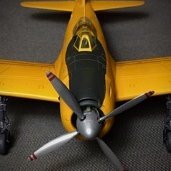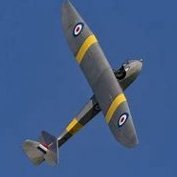-
Posts
1,287 -
Joined
-
Last visited
MDriskill's Achievements

Very Obsessed Member (5/9)
1.7k
Reputation
-
The preceding Re.2000 used a sliding canopy. The later Re.2002 had a hinged canopy similar to the Re.2001, but I don't know whether it was identical or not. Italeri offers a 1/48 scale Re.2002. Per Scalemates, kits and aftermarket bits for this family of machines in 1/48 scale are surprisingly rare.
-
Chris Thomas's research is clear that the larger tailplane was on all Typhoons manufactured with the 4-blade prop. The prop's benefits were lesser vibration, and shortened take-off runs. So, "officially" there were no 4-blade + small tail in-service Typhoons, but it did happen the other way round: 3-blade + big tail. Initial production of the 4-blade prop had faulty oil seals, so one batch of big-tail Typhoons retained the earlier prop. Duggy's post above, and Mr. Thomas's books, describe all this in better detail.
-
Thank you gents! I should have mentioned that my original query followed from hoovering up every Chris Thomas-authored bit I can find on the Typhoon - most recently his superb Wingleader titles.
-
The Hasegawa Typhoon kits of the late 1990's still stand as the best in 1/48 scale, and cover both "car door" and "slider" variants. I recently bought this version of it: As noted on the box it has a 4-blade prop. But this kit - like all Hasegawa's other boxings - has the original smaller tailplane. It's my understanding all operational 4-blader Typhoons had the larger Tempest tailplane. Normally I'd just assume the kit was wrong, but I wondered if it might be an oddball "bitsa" aircraft, field refit, or some such? FWIW, the aircraft covered by this kit's decals are EL-F of 181 Squadron (serial SW494) and TP-Q of 198 Squadron (no serial given).
-
I do not, unfortunately. The F-8 photo above is new to me.
-
For what it's worth - this profile from JaPo's famous books on the Dora has excellent notes on both the possible use of this machine by Rudel, and details of how it was finished.
-
Here's the Scalemates page on the subject. There's nothing newer than what's mentioned above, but a couple of interesting older kits, and Special Hobby's Mk 5 was a bit of a surprise that would stand out on a contest table! https://www.scalemates.com/kits/special-hobby-sh48021-fairey-barracuda-mkii--112249/timeline
-
Well said...and the more I study this subject, the more I'm convinced it's true. A favorite book is Brett Green's Augburg's Last Eagles, with many good photos of the unrestored Bf 109G-6 at Treloar in Australia. This oft-rebuilt mule incorporated parts from several different aircraft, combined with much repair and retouching. The number of different paint colors on it beggars organized description. I especially wonder if the continued use of "old" colors has been fully explored. The regs concerning the "new" ones assumed they would be combined with old stocks. Just speculation, but a good example might be the dark green cowls on the Fw 190D's Jumo 213 power eggs; "83?" 81 variant? Or just leftover 71 from Junkers's bomber-building days?
-
Thanks - I'm glad it was of use. The 190 is a lifelong favorite and I do tend to over-share when questions come up, lol...! Many books have copies of the wartime 190 manual drawings, but this one I took the above diagrams from is worthy of special mention. It was published back in the 1970's but still turns up for fairly regularly. Graphically, it's a near-perfect reproduction of an original manual - down to correct print fonts, etc. - but with the text all translated into perfect English! Very useful indeed.
-
OK, this is purely speculative on my part, but expands on my comments re: the oll cooler above. These diagrams are from the service manual (color notes by me): Note: + The main front cowl ring is steel, doubling as the oil tank and armor. + The narrower ring at the very front is also steel, and protects the oil cooler, which is an annular element running around most of the cowl's opening. + The cooling fan pressurizes the air around the engine, to the extent that air flows through the oil cooler in REVERSE - i.e., it enters from the rear and vents through the low-pressure gap behind the cooler armor ring. + As the A-9's BMW 801S was significantly more powerful than the earlier 801D, it stands to reason it would need more oil cooling capacity. I suspect the cooling element was slightly longer, which means its armor ring would protrude slightly more. Visually it's a fine point, but to my eye photos back this up. + References also indicate the A-9's oil cooler armor was a few millimeters thicker than earlier variants, but this would have negligible visual impact on a scale model. If the front ring is different, we are mostly seeing a longer oil cooler.
-
On second look...my notes on the lower exhausts are a bit confusing. This service manual diagram shows the exhaust arrangement for the A-8. Note that every cylinder has an individual outlet, with the exception of nos. 9 and 10 whose pipes are combined. The cylinder 9/10-7-5-6 outlets are recessed under the cowl, but no. 8 sits outside of the 9/10 pipe, in a small fairing. Supposedly the A-9 had separate outlets for cylinders 9 and 10 - but no. 8 still overlaps them, and sits under the same fairing. So for all practical purposes, there is very little difference to see on a small-scale model.
-
I am fluent in only One Seventy-Two unfortunately! Eduard's kits in this scale are limited to A-5, A-8, and F-8 variants. For a 1/72 A-9, start with one of their A-8 kit variants that had the 4-gun, so-called "universal" wing, i.e., with the subtle "flat bulge" over the outboard gun bays (the A-9's signature wide-blade wood propeller, is on the common detail sprue in all kits though). That being said - research your subject carefully. The A-9 / F-9's main advance was the more powerful BMW 801S engine, distinguished by: slightly deeper oil cooler armor ring (1 in photo); oil pump relief vent under the cowl moved forward (2); revised stacking of underside exhausts (3). Many A-9's reverted to the 12-blade cooling fan when issues with the 14-blader surfaced. And all A-9's did not use the wood prop - any of these blades could be fitted: VDM 9-12153B; "normal" metal type (Eduard's are fine) VDM 9-12153C; same blade, with counterweight bolted to the root VDM 9-12176A; wide wood blade (Eduard's are OK but IMHO Hasegawa's are better) This thread has an insomnia-curing discussion of the A-9 (!), but with good comments, and some useful photos near the end: For what it's worth...old notes of mine detailing the sprues included in Eduard's 1/72 Fw 190 kits. Each sprue in these kits has the number 70110, followed by a suffix letter. The suffixes and descriptions are listed below. Quick notes on my nomenclature: "Early" wing = MG FF cannon in outer bay (for the real-life A-2, 3, 4, 5) "Standard" wing = MG 151 in outer bay, smooth top wing surface (A-6, 7, early 8 ) "Universal" wing = MG 151 or MK 108 in outer bay, bump on top wing surface (A-8, 9; and F-8, 9) "Sturmbock" fuselage = full set of applique armor plate (A-8/R2) "Empty outer gun bay" = flush panel beneath the wing replacing the bulged gun access panel (for so-called “light fighters,” or to mount ordnance racks) The sprues: A - big sprue of common detail parts for all variants B - small sprue of ground attack parts C - A-8 fuselage + universal wing w/MG 151 D - clear parts for all variants E - A-8 Sturmbock fuselage + universal wing w/MK 108 F - F-8 fuselage + universal wing w/empty outer gun bay G - A-5 fuselage + early wing w/MG FF H - A-8 fuselage + standard wing w/MG 151 I - A-8 fuselage + standard wing w/empty outer gun bay J - A-5 fuselage + early wing w/empty outer gun bay The kits released so far have these sprues: SPECIAL EDITIONS R0012, A-8 Royal Class: Ax4, Cx2, Dx4, Ex2, I 2122, Grunherz Dual Combo:Ax2, C, Dx2, G, H, J PROFIPACK ÉDITIONS 70111, A-8 Profipack: A, C, D 70112, A-8/R2 Profipack: A, D, E 70116, A-5 Profipack: A, D, G, J 70119, F-8 Profipack: A, B, D, F WEEKEND EDITIONS 7430, A-8/R2 Weekend: A, D, E 7435, A-8 Standard Wing Weekend: A, D, H 7436, A-5 Heavy Fighter Weekend: A, D, G 7439, A-5 Light Fighter Weekend: A, D, J 7440, F-8 Weekend: A, B, D, F OVERTREE ÉDITIONS 70110X, Small Parts Overtree: A, D 70111X, A-8 Overtree: A, C, D 70112X, A-8/R2 Overtree: A, D, E 70114X, A-8 Early Wings Overtree: A, D, H 70116X, A-5 Smooth Wings Overtree: A, D, J 70117X, A-5 Bulged Wings Overtree: A, D, G 70119X, F-8 Overtree: A, B, D, F Notes: + Sprue I occurs only in the initial Royal Class boxing. + The narrow center bay of all the fuselage - wing sprues (C, and E through J) contains the rudder, tailplanes, and ailerons common to all variants; and all the different nose gun and top cowl panels. It's effectively an extension of sprue A's common parts. + The Royal Class and A-5 Profipack each contain an extra fuselage/wing sprue; the Grunherz Dual Combo has two. Adding the same number of Small Parts Overtrees gives you all the plastic needed for additional complete builds from those boxings. + The Small Parts Overtree is also an awesome fixer/detail set for those Hasegawa, Revell, and Airfix kits still in your stash! As are the normal "leftovers" from any build of the Eduard kit.
-
Your point is well taken. But speaking philosophically, any book of this nature involves a great deal of effort, over a considerable amount of time, to distill thousands of data points - often incomplete, ambiguous, or confilcting - into lucid conclusions. (Having spent many years as an architectural project manager...I never produced a "perfect" set of construction documents, and perforce empathize with similar undertakings!) I don't know Mr. McDermott, or otherwise have any vested interest, and I'm sure the books are not flawless. But to dismiss such an impressive body of work over a single detail seems to me a classic case of "thowing the baby out with the bath water."
-
This lifelong Fw 190 fan snapped up all four of Mr. McDermott's books on late radial-engine ones (NDW, Arado, Fieseler, and AGO), and they are fascinating indeed. He is an interesting guy who works a bit outside the usual gang of Luftwaffe experts (although several did help, and are acknowledged). He is a high-level modeler himself (former IPMS-USA Nationals "best aircraft" winner), and an auto-body repair technician by profession. He absolutely knows his away around colors, painting equipment, and application methods, and has a great eye for detail. The idea that a 190's manufacturer could be accurately identified by finish details was pioneered by the acclaimed JaPo and Crandall volumes on the Fw 190D. These books take the same idea to literally "the next level" for late-war radial-engine variants: researching each manufacturer's sub-contractors, and how their parts were finished. Each volume involves decades of research; scouring of various archives for photos, intelligence reports, bombing surveys, etc.; and much more. There are some unpublished photos and good color profiles in each book. Yes, there's stuff in each one that the experts will contest, but I'm not prepared to argue with any of 'em (and I sense their opinions are not too important to this author anyway, ha). Whether you agree with every tidbit or not, you will, IMHO, find these unique books well worth having.
- 184 replies
-
- 11
-

-











